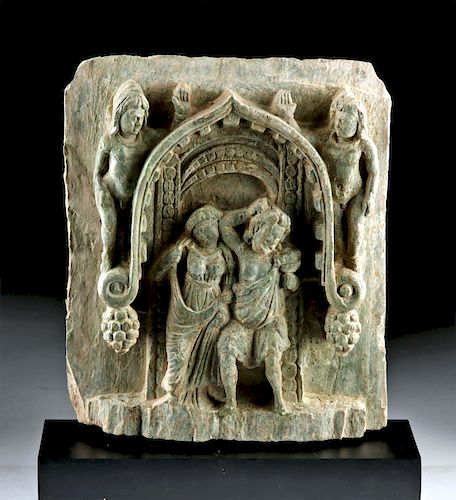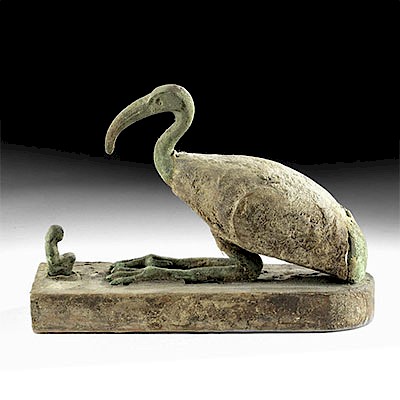Gandharan Glazed Schist Relief w/ Dionysiac Scene
Lot 124
About Seller
Artemis Gallery
686 S Taylor Ave, Ste 106
Louisville, CO 80027
United States
Selling antiquities, ancient and ethnographic art online since 1993, Artemis Gallery specializes in Classical Antiquities (Egyptian, Greek, Roman, Near Eastern), Asian, Pre-Columbian, African / Tribal / Oceanographic art. Our extensive inventory includes pottery, stone, metal, wood, glass and textil...Read more
Estimate:
$3,200 - $4,800
Absentee vs Live bid
Two ways to bid:
- Leave a max absentee bid and the platform will bid on your behalf up to your maximum bid during the live auction.
- Bid live during the auction and your bids will be submitted real-time to the auctioneer.
Bid Increments
| Price | Bid Increment |
|---|---|
| $0 | $25 |
| $300 | $50 |
| $1,000 | $100 |
| $2,000 | $250 |
| $5,000 | $500 |
| $10,000 | $1,000 |
| $20,000 | $2,500 |
| $50,000 | $5,000 |
| $100,000 | $10,000 |
| $200,000 | $20,000 |
About Auction
By Artemis Gallery
Oct 31, 2019
Set Reminder
2019-10-31 10:00:00
2019-10-31 10:00:00
America/New_York
Bidsquare
Bidsquare : Fine Antiquities, Asian, Ethnographic Art
https://www.bidsquare.com/auctions/artemis-gallery/fine-antiquities-asian-ethnographic-art-4581
Our Halloween Day auction features classical antiquities, ancient and ethnographic art from cultures encompassing the globe, plus fine art. Artemis Gallery info@artemisgallery.com
Our Halloween Day auction features classical antiquities, ancient and ethnographic art from cultures encompassing the globe, plus fine art. Artemis Gallery info@artemisgallery.com
- Lot Description
Central Asia, Pakistan and Afghanistan, Gandharan Empire, ca. 200 BCE to 100 CE. A fascinating high relief Dionysiac scene, hand-carved in schist and glazed with a deep, forest green. Two figures, a man and a woman, stand underneath an ornate arch. Each wears Classical-style clothing, the drapes and folds skillfully depicted by the artist. The man, who is bearded and holds a chalice, appears to be supported by the woman, as if he is staggeringly drunk. At either side of the arch, standing on its curlicued ends, is a nude male figure wearing a large necklace and looking down on the scene with a single hand raised. Below the curlicues are thick bunches of grapes. Size: 8.55" W x 10.5" H (21.7 cm x 26.7 cm); 12" H (30.5 cm) on included custom stand.
Gandharans are famous for their schist carvings. Vast monastic institutions like those at Takht-i-Bahi, Sahri-Bahlol, Jamal Garhi, Ranigat, and Thareli were decorated by skilled artisans with carved representations of important figures, religious scenes, and artistic dedications. During this time, Gandhara was exceptionally wealthy, profiting from trade along the Silk Road; patrons had resources to spend on the arts, creating a flowering of artwork. Some of this artwork is thought to be inspired by Dionysus and the Greco-Roman influence on Gandharan art and culture. The male figure with his chalice and the grapes signify the meaning of this scene.
Provenance: ex-private J. Mazard collection, New York, USA, acquired in the 1980s
All items legal to buy/sell under U.S. Statute covering cultural patrimony Code 2600, CHAPTER 14, and are guaranteed to be as described or your money back.
A Certificate of Authenticity will accompany all winning bids.
We ship worldwide and handle all shipping in-house for your convenience.
#145858Repaired at base, left side (facing), and the torso and leg of the central male figure. With an applied green glaze that is ancient and light deposits on the surface.Condition
- Shipping Info
-
All shipping is handled in-house for your convenience. Your invoice from Artemis Gallery will include shipping calculation instructions. If in doubt, please inquire BEFORE bidding for estimated shipping costs for individual items.
-
- Buyer's Premium



 EUR
EUR CAD
CAD AUD
AUD GBP
GBP MXN
MXN HKD
HKD CNY
CNY MYR
MYR SEK
SEK SGD
SGD CHF
CHF THB
THB














